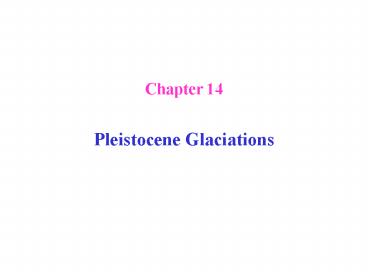Pleistocene Glaciations - PowerPoint PPT Presentation
1 / 21
Title:
Pleistocene Glaciations
Description:
Precession (related to direction of the spin axis) modifies the relationship ... the sun every half precession cycle the hemisphere with the greatest degree of ... – PowerPoint PPT presentation
Number of Views:106
Avg rating:3.0/5.0
Title: Pleistocene Glaciations
1
Chapter 14 Pleistocene Glaciations
2
Maximum extent of the Pleistocene ice sheet
3
As a response to climate changes ice sheets
advance over the continents and this changes are
recorded in the chemical changes that take place
in the ocean. Oxygen isotopes analysis is used to
determine the record of glacial-interglacial
oscillations.
In general, if the waters are cold sediments will
have more 18O. Evaporation transfers 16O
preferentially but product of condensation
contains more 18O (heavier), so 18O goes with the
rain and 16O is left behind in the atmosphere
which ends up in the ice sheets. Thus there is a
net transfer of 16O from oceans to ice sheets,
which now leaves behind (in the oceans) water
rich in 18O.
4
Deep-sea sediment record of the 18d of seawater
during the Pleistocene analysis on two genera,
sediments from mid-latitude North Atlantic.
5
Milankovictch Cycles periodical changes in the
Earths climate system due to (1) changes in the
orbit around the Sun 100,00 years period, (2)
changes in the inclination of the rotation axis
41,000 years period, and (3) changes in the
orientation of the rotation axis with respect of
the orbit 26,000 years period.
6
Obliquity and contrast in insolation between the
seasons
7
Glaciations Sun is in one of the foci of the
ellipse, at perihelion earth is closer to the sun
than at aphelion more energy at perihelion than
aphelion perihelion when Northern Hemisphere
(NH) is in the middle of winter earth moves
faster in its orbit around the sun at perihelion
than at aphelion therefore NH winters are
milder and shorter than Southern Hemisphere (SH)
winters and NH summers tend to be longer and
milder than milder than SH summers Obliquity
creates contrast between the seasons, no net
change in the amount of sunlight received by
earth the eccentricity of earths orbit causes
this contrast to slightly greater in the SH than
in the NH Precession (related to direction of the
spin axis) modifies the relationship between the
seasons and the distance from the sun every
half precession cycle the hemisphere with the
greatest degree of seasonal contrast switches
between north and south when the SH has mild
summers and winters, the NH has hot summers and
cold winters and vice versa. Glaciations are
promoted with northern summer at aphelion and
thus low seasonal contrast (as today). In
Summary when eccentricity is large, NH
glaciation is especially favored when precession
causes the NH summer to occur at aphelion.
8
Combination of various orbital forcing causes
earths climate to oscillate between two states
glacial and interglacial. These equilibrium
states can be represented as below, with the
glacial state in a deeper valley than the
interglacial state. Orbital forcing periodically
and continually send the system from one valley
to the other, back and forth.
9
(No Transcript)
10
- Glacial Climate Feedbacks
- Ice-Albedo Feedbacks
- Vostok Ice Core link between global climate
change and variations of GHGs amount in the
atmosphere - Feedbacks affecting atmospheric CO2 on Glacial
Time Scales - Changes in Terrestrial Biomass
- Cloud-Albedo Feedbacks
11
1. GLACIAL CYCLES THE VOSTOK ICE-CORE DATA
C02, CH4, and temperature time series for the
last 400,000 years How are they derived
isotope analysis (O and H) These co-varying
changes are interpreted as evidence of
system-like behavior
12
(No Transcript)
13
The marine biological pump
14
(No Transcript)
15
(No Transcript)
16
(No Transcript)
17
(No Transcript)
18
Difference in vegetation between the last glacial
maximum and what potentially we could have today
- human activities have already decreased the
forest, which increased with respect to 18 k. y
ago, shown in here.
19
(No Transcript)
20
MSA content of Antarctic ice (bottom) and
relative local temperature (top) from hydrogen
isotopic composition of the ice.
21
(No Transcript)































